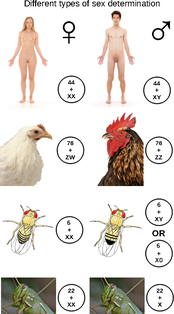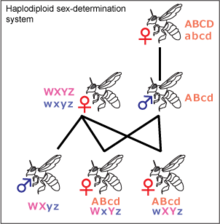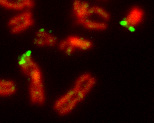Sex-determination system

A sex-determination system is a biological system that determines the development of sexual characteristics in an organism.[1] Most organisms that create their offspring using sexual reproduction have two common sexes and a few less common intersex variations.
In some species, there are
In some species, sex determination is genetic: males and females have different
In other cases, sex of a fetus is determined by environmental variables (such as temperature). The details of some sex-determination systems are not yet fully understood. Hopes [who?] for future fetal biological system analysis include complete-reproduction-system initialized signals that can be measured during pregnancies to more accurately determine whether a determined sex of a fetus is male, or female.[citation needed] Such analysis of biological systems could also signal whether the fetus is hermaphrodite, which includes total or partial of both male and female reproduction organs.
Some species such as various plants and fish do not have a fixed sex, and instead go through life cycles and change sex based on genetic cues during corresponding life stages of their type. This could be due to environmental factors such as seasons and temperature. In some gonochoric species, a few individuals may have sex characteristics of both sexes, a condition called intersex.[3]
While diversity in sex determination systems is common throughout different biological systems, the systems beyond XY/XX/XO in mammals are often left to more advanced courses for those whose studies specialize in genetics of other organisms.
Discovery
This section needs expansion. You can help by adding to it. (June 2021) |
Sex determination was discovered in the mealworm by the American geneticist Nettie Stevens in 1903.[4][5][6]
In 1694, J.R. Camerarius, conducted early experiments on pollination and reported the existence of male and female characteristics in plants(Maize).
In 1866,
In 1902, C.E. McClung identified sex chromosomes in bugs.
In 1917, C.E. Allen, discovered sex determination mechanisms in plants.
In 1922, C.B. Bridges, put forth the Genic Balance Theory of sex determination.
Chromosomal systems
XX/XY sex chromosomes

The XX/XY sex-determination system is the most familiar, as it is found in humans. The XX/XY system is found in most other
Y-centered sex determination
Some species (including humans) have a gene
In Y-centered sex determination, the SRY gene is the main gene in determining male characteristics, but multiple genes are required to develop testes. In XY mice, lack of the gene
X-centered sex determination
Some species, such as fruit flies, use the presence of two X chromosomes to determine femaleness.[13] Species that use the number of Xs to determine sex are nonviable with an extra X chromosome.
Other variants of XX/XY sex determination
Some fish have variants of the XY sex-determination system, as well as the regular system. For example, while having an XY format, Xiphophorus nezahualcoyotl and X. milleri also have a second Y chromosome, known as Y', that creates XY' females and YY' males.[14]
At least one

XX/X0 sex chromosomes
In this variant of the XY system, females have two copies of the sex chromosome (XX) but males have only one (X0). The 0 denotes the absence of a second sex chromosome. Generally in this method, the sex is determined by amount of genes expressed across the two chromosomes. This system is observed in a number of insects, including the grasshoppers and crickets of order
The nematode C. elegans is male with one sex chromosome (X0); with a pair of chromosomes (XX) it is a hermaphrodite.[18] Its main sex gene is XOL, which encodes XOL-1 and also controls the expression of the genes TRA-2 and HER-1. These genes reduce male gene activation and increase it, respectively.[19]
ZW/ZZ sex chromosomes
The ZW sex-determination system is found in birds, some reptiles, and some insects and other organisms. The ZW sex-determination system is reversed compared to the XY system: females have two different kinds of
In both XY and ZW sex determination systems, the sex chromosome carrying the critical factors is often significantly smaller, carrying little more than the genes necessary for triggering the development of a given sex.
ZZ/Z0 sex chromosomes
The ZZ/Z0 sex-determination system is found in some moths. In these insects there is one sex chromosome, Z. Males have two Z chromosomes, whereas females have one Z. Males are ZZ, while females are Z0.[26][27][28]
UV sex chromosomes
In some bryophyte and some algae species, the gametophyte stage of the life cycle, rather than being hermaphrodite, occurs as separate male or female individuals that produce male and female gametes respectively. When meiosis occurs in the sporophyte generation of the life cycle, the sex chromosomes known as U and V assort in spores that carry either the U chromosome and give rise to female gametophytes, or the V chromosome and give rise to male gametophytes.[29][30]

Haplodiploidy
Other chromosomal systems
Other uncommon systems include those of the
Mating type in microorganisms is analogous to sex in multi-cellular organisms, and is sometimes described using those terms, though they are not necessarily correlated with physical body structures. Some species have more than two mating types. Tetrahymena, a type of ciliate, has seven mating types. Schizophyllum commune, a type of fungus, has 23,328.
Environmental systems

Temperature-dependent
Many other sex-determination systems exist. In some species of reptiles, including
It is unknown how exactly temperature-dependent sex determination evolved.[38] It could have evolved through certain sexes being more suited to certain areas that fit the temperature requirements. For example, a warmer area could be more suitable for nesting, so more females are produced to increase the amount that nest next season.[38] In amniotes, environmental sex determination preceded the genetically determined systems of birds and mammals; it is thought that a temperature-dependent
Other environmental systems
There are other environmental sex determination systems including location-dependent determination systems as seen in the marine worm Bonellia viridis – larvae become males if they make physical contact with a female, and females if they end up on the bare sea floor. This is triggered by the presence of a chemical produced by the females, bonellin.[40] Some species, such as some snails, practice sex change: adults start out male, then become female. In tropical clownfish, the dominant individual in a group becomes female while the other ones are male, and bluehead wrasses (Thalassoma bifasciatum) are the reverse. Some species, however, have no sex-determination system. Hermaphrodite species include the common earthworm and certain species of snails. A few species of fish, reptiles, and insects reproduce by parthenogenesis and are female altogether. There are some reptiles, such as the boa constrictor and Komodo dragon that can reproduce both sexually and asexually, depending on whether a mate is available.[41]
Evolution

Sex determination systems may have evolved from mating type, which is a feature of microorganisms.
Chromosomal sex determination may have evolved early in the history of eukaryotes.[42] But in plants it has been suggested to have evolved recently.[43]
The accepted hypothesis of XY and ZW sex chromosome evolution in amniotes is that they evolved at the same time, in two different branches.[44][45]
No genes are shared between the avian ZW and mammal XY chromosomes
However, there is some evidence to suggest that there could have been transitions between ZW and XY, such as in
There are some vertebrate species, such as the
See also
- Clarence Erwin McClung, who discovered the role of chromosomes in sex determination
- Testis-determining factor
- Maternal influence on sex determination
- Sequential hermaphroditism
- Sex determination and differentiation (human)
- Sexing
References
- ^ Schnebly, Risa Aria (2021). "Sex Determination in Humans". The Embryo Project Encyclopedia. Retrieved 6 July 2022.
- ISBN 978-3-319-47829-6.
- ISBN 978-1108499859. Archivedfrom the original on 11 October 2020. Retrieved 11 October 2020.
- ^ "Nettie Stevens: A Discoverer of Sex Chromosomes | Learn Science at Scitable". www.nature.com. Archived from the original on 7 April 2019. Retrieved 7 June 2018.
- PMID 11620765.
- ^ "Nettie Maria Stevens (1861–1912) | The Embryo Project Encyclopedia". embryo.asu.edu. Archived from the original on 8 April 2019. Retrieved 7 June 2018.
- ^ a b c d e Hake L (2008). "Genetic Mechanisms of Sex Determination". Nature Education. 1 (1). Archived from the original on 19 August 2017. Retrieved 8 December 2011.
- S2CID 19764423.
- ^ a b Chandra, H. S. (25 April 1999). "Another way of looking at the enigma of sex determination in Ellobius lutescens". Current Science. 76 (8): 1072.
- PMID 21208124.
- PMID 10588843.
- PMID 20005806.
- PMID 12966139.
- ^ S2CID 17401686.
- PMID 18464734.
- S2CID 23603889.
- S2CID 23311263.
- ^ ISBN 978-0-691-00981-0. Retrieved 4 November 2011.
- PMID 1498366.
- S2CID 4413389.
- S2CID 205238635.
- S2CID 12932564.
- S2CID 4379897.
- ^ "Virgin births for giant lizards". BBC News. 20 December 2006. Archived from the original on 4 November 2014. Retrieved 13 March 2008.
- ^ "Evolution of the Y Chromosome". Annenberg Media. Archived from the original on 4 November 2004. Retrieved 1 April 2008.
- S2CID 6885122.
- ^ "Genetic Mechanisms of Sex Determination - Learn Science at Scitable". www.nature.com. Archived from the original on 19 August 2017. Retrieved 8 December 2011.
- ISBN 9783110162103– via Google Books.
- PMID 21962970.
- .
- PMID 12941271.
- PMID 23466984.
- PMID 29408414.
- PMID 16393347.
- PMID 17148121.
- ^ PMID 12409092.
- S2CID 85177125.
- ^ a b Valenzuela N, Janzen FJ (2001). "Nest-site philopatry and the evolution of temperature-dependent sex determination" (PDF). Evolutionary Ecology Research. 3: 779–794. Archived (PDF) from the original on 4 May 2013. Retrieved 7 December 2011.
- S2CID 15485510.
- ISBN 9780878932504.
- S2CID 4311088.
- PMID 25323972.
- ISBN 978-0-520-29248-2.
- PMID 19461890.
- ^ PMID 17116892.
- S2CID 12932564.
- PMID 18463302.
- PMID 10952906.
- S2CID 18864471.
- PMID 21212104.
- ^ S2CID 8379688.
- ^ "The evolution of the sex chromosomes: Step by step" (Press release). University of Chicago Medical Center. 28 October 1999. Retrieved 23 October 2011.
- PMID 12952526.
- S2CID 23740483.
- PMID 22367542.
- PMID 24983465.
- ISBN 978-0-19-163781-0.
Further reading
- Beukeboom L, Perrin N (2014). The Evolution of Sex Determination. Oxford University Press. ISBN 978-0-19-163140-5.
